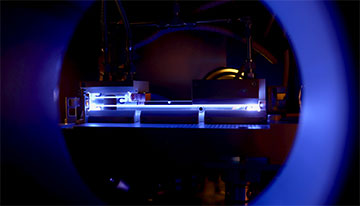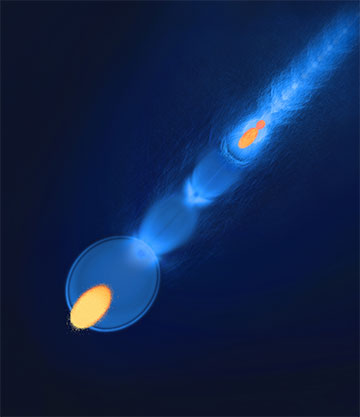
Two FLASHForward plasma cells. The cells are filled with argon gas that can be ionized with a high-voltage electrical discharge to form a plasma. As the plasma recombines, it emits light in the blue wavelength range. The cells can then be used for plasma acceleration of electron bunches in gigavolt-per-meter accelerating gradients. [Image: DESY, C.A. Lindstrøm]
Plasma technology holds the promise of being able to accelerate charged particles to extremely high energies over very short distances—and therefore at much lower costs than the kilometer-scale facilities of today. But to really be practical, such devices need to up their repetition rates by several orders of magnitude.
To find out just how rapidly these accelerators could operate in principle, researchers at the DESY laboratory in Germany have measured the time a plasma takes to recover its initial state after a passing high-speed particle beam sets up a wakefield within it. Their result: a few tens of nanoseconds—short enough to satisfy the megahertz frequencies needed for the most demanding particle colliders and light sources (Nature, doi: 10.1038/s41586-021-04348-8).
Emerging accelerator
Plasma wakefield accelerators can create electric field gradients as high as several gigavolts per meter by firing either very intense laser pulses or particle bunches into a plasma and setting up oscillations in the plasma’s electrons behind them. Charged particles either from within the plasma itself or injected from outside can ride on this wake like surfers on a water wave to attain very high energies in just a few centimeters (see “Surfing the Wakefield,” OPN, February 2022).
These gradients are far higher than those achievable in conventional accelerators based on radio-frequency (RF) cavities, the surfaces of which start to break down above a certain field strength. As such, scientists are attempting to develop plasma-based accelerators for slimmed-down particle colliders (such as a next-generation electron–positron machine), and to power free-electron lasers (FELs) for use in research, industry and medicine—and that could potentially be housed on the premises of individual universities or hospitals.
Repetition rate, however, remains a major hurdle. The necessary luminosities of particle colliders and the brilliance of FELs require that the laser pulses or particle bunches driving a plasma accelerator be generated thousands or even millions of times per second. The wakefield devices developed to date, in contrast, typically operate at no more than a few hertz.
Firing electron bunches
In the latest work, researchers based in Germany and the United Kingdom, led by Richard D’Arcy and Jens Osterhoff at DESY, set out to establish for how long the particles driving the wakefield leave a plasma perturbed. Unlike the long-lived electromagnetic waves in an RF cavity, a plasma wakefield dissipates after just a few oscillations and so has to be re-established for each new accelerated particle bunch. The time needed for the plasma to settle back to its original state therefore imposes an upper limit on an accelerator’s repetition rate.

An illustration of a probe-bunch pair sampling a plasma perturbed by the leading bunch. [Image: DESY, M. Lindstrøm, Mortani Design and Illustration]
For this task, the researchers used the superconducting linear accelerator in DESY’s FLASH facility. This machine is used mainly as a source of electrons for a free-electron laser at soft X-ray wavelengths, but some of its output is instead tapped by a beamline known as FLASHForward that incorporates a plasma cell for studies of beam-driven plasma wakefield experiments.
The experiment in this case involved ionizing a capillary tube filled with argon gas and then firing three bunches of electrons into the resulting plasma. The idea was to measure the effect of the wakefield created by the first bunch on the latter two, closely-spaced bunches. With the leading bunch far enough ahead, its effect on the plasma disappears before the other two bunches pass through. Otherwise its perturbation impacts the ability of the second bunch to accelerate the third with its own wakefield.
Discovering maximum repetition rate
D’Arcy, Osterhoff and colleagues exploited FLASH’s high-frequency operation to precisely vary the delay between bunches, and then used a dipole magnet ahead of a scintillating screen to measure the spatial distribution and energy spectra of all three bunches as they emerged from the capillary tube. They found that the spectra and charge density of the trailing bunches remained constant in time so long as they were at least 63 ns behind the leading bunch. In contrast, once they got any closer, their measured parameters began to fluctuate.
By comparing these experimental results with computer simulations of the plasma channel, the researchers concluded that this delay represented the time needed for the plasma to return to its initial state after being perturbed by the leading pulse. This translates into a maximum repetition rate of around 15 MHz, which, they say, would potentially enable a plasma device to be added to the end of an existing high-repetition rate accelerator in order to boost the latter’s energy.
However, as the researchers point out, this theoretical upper limit does not necessarily translate to high repetition rates in practice. Both laser-driven and particle-driven plasma accelerators are potentially limited by the heat generated as electrons within the plasma give off energy to the walls of the capillary tube. This heat could affect the acceleration process itself and also damage the tube.
Establishing the extent of such heating effects will be among the aims of future experiments to be carried out by the researchers at FLASHForward. They also plan to investigate how the quality of incoming particle beams can be maintained as well as ensuring that the acceleration process is as energy-efficient as possible—both “essential goals,” says D’Arcy, if plasma technology is to find meaningful application in future light sources and particle colliders.
